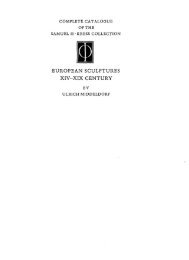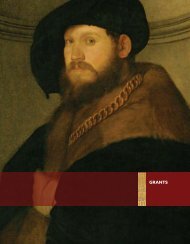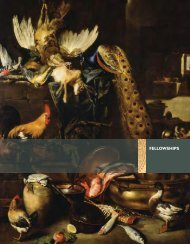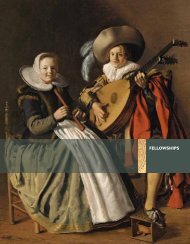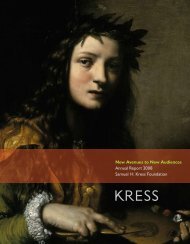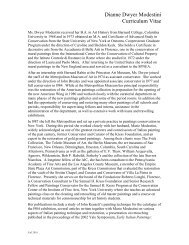The Campus Art Museum - Samuel H. Kress Foundation
The Campus Art Museum - Samuel H. Kress Foundation
The Campus Art Museum - Samuel H. Kress Foundation
You also want an ePaper? Increase the reach of your titles
YUMPU automatically turns print PDFs into web optimized ePapers that Google loves.
<strong>The</strong> Report/s<br />
<strong>The</strong> study is written as four reports, each one focused on one of the research<br />
questions described above. Each report can be read independent of the other<br />
reports. <strong>The</strong>refore some repetition about the overall study will be found on the<br />
first few pages of each, usually inserted as footnotes. <strong>The</strong> reports are briefly<br />
summarized below. Results from this study are meant to enhance institutional and<br />
public recognition of the contributions campus art museums can make to multiple<br />
constituencies and to help identify how the philanthropic sector can best serve<br />
campus art museums.<br />
Around fifty years ago, the <strong>Samuel</strong> H. <strong>Kress</strong> <strong>Foundation</strong> distributed works<br />
of art to two-dozen colleges and universities throughout the United States, and<br />
eighteen regional museums in addition to the National Gallery of <strong>Art</strong>, in what<br />
has been referred to as “<strong>The</strong> Great <strong>Kress</strong> Giveaway.” <strong>The</strong> first report, Effects and<br />
Influences of “<strong>The</strong> Great <strong>Kress</strong> Giveaway,” helps shed light on how these works of<br />
art have been used and what differences the gifts have made for museums, students,<br />
faculty, and communities. <strong>The</strong> report addresses how the <strong>Kress</strong> works provided<br />
legitimacy and credibility for new campus museums and were responsible, in some<br />
cases, for the very formation of a campus art museum. It shows how the <strong>Kress</strong><br />
donations have bolstered arguments for more gallery space or museum renovations,<br />
for new staff positions, and consistently have served to attract further donations<br />
to the museums’ collections, complementing objects donated by <strong>Kress</strong>. <strong>The</strong> works<br />
are valued for research projects that vary from art history essay assignments to<br />
dissertations to extensive scientific research undertaken through the collaboration<br />
of several institutions. Most all the <strong>Kress</strong> pieces are on permanent display, serving<br />
as an anchor and mainstay for museum tours and educational programs. <strong>The</strong>y<br />
are widely used in art history classes, but also in other courses including religion,<br />
music, area studies, history, and business. Finally, the <strong>Kress</strong> gifts have provided<br />
access to art of a high caliber in areas where such access has been limited, and for<br />
that, people are especially grateful.<br />
<strong>Art</strong> Across the Curriculum focuses on academic involvement, on the acts of<br />
thinking, learning, experiencing, and creativity enabled by campus art museums.<br />
It addresses the ways in which campus art museums reach out to faculty in support<br />
of teaching and research, and how the art museums help faculty achieve various<br />
educational objectives. Each objective is discussed with examples, demonstrating<br />
how faculty across the curriculum are using the campus art museum, sometimes<br />
initiated on their own, but often assisted by museum personnel. It looks at different<br />
modes of collaboration among faculty and museum staff, including ways in which<br />
museum exhibitions are constructed or interpreted for use in academic classes and<br />
how faculty’s expertise and research are incorporated into exhibitions. <strong>The</strong> report<br />
also considers ways in which the Mellon <strong>Foundation</strong>, in particular, has assisted in<br />
activating the academic integration of art across the curriculum.<br />
<strong>Museum</strong> <strong>Art</strong> in Everyday Life explicates how students, faculty, and the<br />
public interact with the campus art museum beyond the academic curriculum and<br />
what meaning the campus art museum holds for study participants. This report<br />
identifies factors that have influenced participants’ interest in art and art museums:<br />
<strong>The</strong> <strong>Campus</strong> <strong>Art</strong> <strong>Museum</strong>: A Qualitative Study: Preface<br />
6



